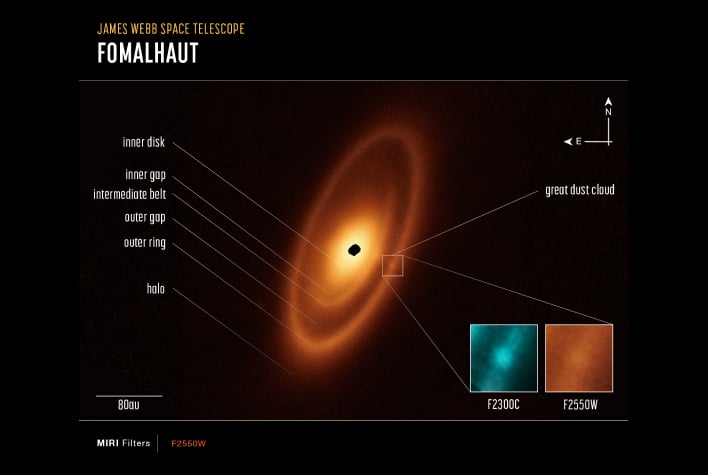Why This JWST Image Of A Nearby Star Dressed In An Asteroid Belt Has NASA Stunned
NASA's Hubble Telescope, Herschel Space Observatory, and the Atacama Large Millimeter/submillimeter Array (ALMA) have all previously imaged the outer belt around the young star known as Formalhaut. Those previous images, however, were unable to detect what JWST was able to capture with its Mid-Infrared Instrument (MIRI), which was two additional belts. In total, the three belts extend out to 14 billion miles from Formalhaut, an astounding distance of 150 times that of Earth from the Sun.
"Where Webb really excels is that we're able to physically resolve the thermal glow from dust in those inner regions. So you can see inner belts that we could never see before," remarked Schuyler Wolff, a team member at the University of Arizona.
The three dusty belts originated from collisions of larger bodies, analogous to asteroids and comets, and are referred to as 'debris disks,' according to NASA. The belts surround the young star and can be seen with the naked eye as the brightest star in the southern constellation Piscis Austrinus.
"I would describe Formalhaut as the archetype of debris disks found elsewhere in our galaxy, because it has components similar to those we have in our own planetary system," explained Andras Gaspar of the University of Arizona in Tucson and lead author of a paper describing the results of the study. "By looking at the patterns in these rings, we can actually start to make a little sketch of what a planetary system ought to look like - If we could actually take a deep enough picture to see the suspended planets."
The belts are believed to have been created by the gravitational forces produced by undetected planets. In a similar manner, the inner edge of the Kuiper Belt is sculpted by Neptune, while Jupiter "corrals the asteroid belt."
"We definitely didn't expect the more complex structure with the second intermediate belt and then the broader asteroid belt," Wolff added. "That structure is very exciting because any time an astronomer sees a gap and rings in a disk, they say, 'There could be an embedded planet shaping the rings!'"



